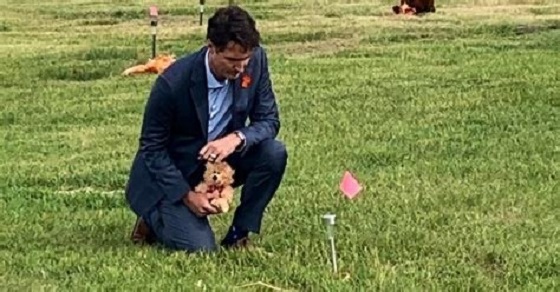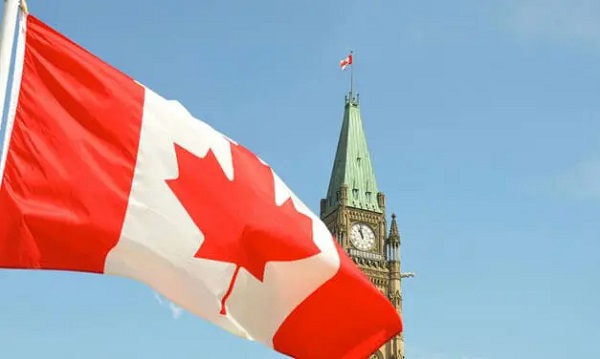Indigenous
Trudeau gov’t increases funding for residential school ‘grave’ search despite no bodies being found

From LifeSiteNews
The $238.8 million budgeted in 2022 for a Residential Schools Missing Children Community Support Fund initially had a $500,000 limit per grant application, a limit that has now been repealed despite no bodies being found.
The federal cabinet of Prime Minster Justin Trudeau is expanding a multi-million-dollar fund which is geared towards documenting thus far unfounded claims that hundreds of young children died at a now-closed residential schools, some of them run by the Catholic Church.
The $238.8 million budgeted in 2022 for a Residential Schools Missing Children Community Support Fund initially had a $500,000 limit per grant application and included an amount up to $300,000 designated for “field work.”
The funding limits have now been repealed, however, as per Blacklock’s Reporter, with no details having been given by the department on what the new costs will be.
As noted by Crown-Indigenous Relations Minister Gary Anandasangaree in a recent statement, “We know this funding and these supports will never be enough to fully repair the intergenerational trauma.”
According to the department, its “intention was to fund as many initiatives as possible, but we recognize the lack of flexibility in these changes was a mistake.”
The initial funds budgeted in 2022 to aid in “locating burial sites linked to former Residential Schools” is set to expire in 2025, with some $216.5 million having been spent.
A total of $7.9 million granted for fieldwork has resulted in no human remains having been found to date.
In 2021 and 2022, the mainstream media ran with inflammatory and dubious claims that hundreds of children were buried and disregarded by Catholic priests and nuns who ran some of the schools.
The Tk’emlups te Secwepemc First Nation was more or less the reason there was a large international outcry in 2021 when it claimed it had found 215 “unmarked graves” of kids at the Kamloops Residential School. The claims of remains, however, were not backed by physical evidence but were rather disturbances in the soil picked up by ground-penetrating radar.
The First Nation now has changed its claim of 215 graves to 200 “potential burials.”
As reported by LifeSiteNews, Prime Minster Justin Trudeau as recently as June again falsely stated that “unmarked graves” were discovered at former residential schools.
Canada’s Department of Crown-Indigenous Relations has confirmed it has spent millions searching for “unmarked graves” at a now-closed residential schools.
Canadian indigenous residential schools, while run by both the Catholic Church and other Christian churches, were mandated and set up by the federal government and ran from the late 19th century until the last school closed in 1996.
While there were indeed some Catholics who committed serious abuses against native children, the unproved “mass graves” narrative has led to widespread anti-Catholic sentiment since 2021.
While some children did die at the once-mandatory boarding schools, evidence has revealed that many of the children tragically passed away because of unsanitary conditions due to the federal government, not the Catholic Church, failing to properly fund the system.
Business
Natural gas pipeline ownership spreads across 36 First Nations in B.C.

Chief David Jimmie is president of Stonlasec8 and Chief of Squiala First Nation in B.C. He also chairs the Western Indigenous Pipeline Group. Photo courtesy Western Indigenous Pipeline Group
From the Canadian Energy Centre
Stonlasec8 agreement is Canada’s first federal Indigenous loan guarantee
The first federally backed Indigenous loan guarantee paves the way for increased prosperity for 36 First Nations communities in British Columbia.
In May, Canada Development Investment Corporation (CDEV) announced a $400 million backstop for the consortium to jointly purchase 12.5 per cent ownership of Enbridge’s Westcoast natural gas pipeline system for $712 million.
In the works for two years, the deal redefines long-standing relationships around a pipeline that has been in operation for generations.
“For 65 years, there’s never been an opportunity or a conversation about participating in an asset that’s come through the territory,” said Chief David Jimmie of the Squiala First Nation near Vancouver, B.C.
“We now have an opportunity to have our Nation’s voices heard directly when we have concerns and our partners are willing to listen.”
Jimmie chairs the Stonlasec8 Indigenous Alliance, which represents the communities buying into the Enbridge system.
The name Stonlasec8 reflects the different regions represented in the agreement, he said.
The Westcoast pipeline stretches more than 2,900 kilometres from northeast B.C. near the Alberta border to the Canada-U.S. border near Bellingham, Wash., running through the middle of the province.

It delivers up to 3.6 billion cubic feet per day of natural gas throughout B.C. and the Lower Mainland, Alberta and the U.S. Pacific Northwest.
“While we see the benefits back to communities, we are still reminded of our responsibility to the land, air and water so it is important to think of reinvestment opportunities in alternative energy sources and how we can offset the carbon footprint,” Jimmie said.
He also chairs the Western Indigenous Pipeline Group (WIPG), a coalition of First Nations communities working in partnership with Pembina Pipeline to secure an ownership stake in the newly expanded Trans Mountain pipeline system.
There is overlap between the communities in the two groups, he said.
CDEV vice-president Sébastien Labelle said provincial models such as the Alberta Indigenous Opportunities Corporation (AIOC) and Ontario’s Indigenous Opportunities Financing Program helped bring the federal government’s version of the loan guarantee to life.
“It’s not a new idea. Alberta started it before us, and Ontario,” Labelle said.
“We hired some of the same advisors AIOC hired because we want to make sure we are aligned with the market. We didn’t want to start something completely new.”
Broadly, Jimmie said the Stonlasec8 agreement will provide sustained funding for investments like housing, infrastructure, environmental stewardship and cultural preservation. But it’s up to the individual communities how to spend the ongoing proceeds.
The long-term cash injections from owning equity stakes of major projects can provide benefits that traditional funding agreements with the federal government do not, he said.
Labelle said the goal is to ensure Indigenous communities benefit from projects on their traditional territories.
“There’s a lot of intangible, indirect things that I think are hugely important from an economic perspective,” he said.
“You are improving the relationship with pipeline companies, you are improving social license to do projects like this.”
Jimmie stressed the impact the collaborative atmosphere of the negotiations had on the success of the Stonlasec8 agreement.
“It takes true collaboration to reach a successful partnership, which doesn’t always happen. And from the Nation representation, the sophistication of the group was one of the best I’ve ever worked with.”
Indigenous
Carney’s Throne Speech lacked moral leadership

This article supplied by Troy Media.
 By Susan Korah
By Susan Korah
Carney’s throne speech offered pageantry, but ignored Indigenous treaty rights, MAID expansion and religious concerns
The Speech from the Throne, delivered by King Charles III on May 27 to open the latest session of Parliament under newly elected Prime Minister Mark Carney, was a confident assertion of Canada’s identity and outlined the government’s priorities for the session. However, beneath the
pageantry, it failed to address the country’s most urgent moral and constitutional responsibilities.
It also sent a coded message to U.S. President Donald Trump, subtly rebuking his repeated dismissal of Canada as a sovereign state. Trump has
previously downplayed Canada’s independence in trade talks and public statements, often treating it as economically subordinate to the U.S.
Still, a few discordant notes—most visibly from a group of First Nations chiefs in traditional headdresses—cut through the welcoming sounds that greeted the King and Queen Camilla on the streets of the capital.
The role of the Crown in Canada’s history sparked strong reactions from some Indigenous leaders who had travelled from as far as Alberta and Manitoba to voice their concerns.
“It’s time the Crown paid more than lip service to the Indigenous people of this country,” Chief Billy-Joe Tuccaro of the Mikisew Cree First Nation told me as he and his colleagues posed for photographs requested by several parade spectators. “We have been ignored and marginalized for far too long.”
He added that he and fellow chiefs from other First Nations were standing outside the Senate chamber as a symbol of their status as “outsiders,” despite being the land’s original inhabitants.
Shortly after Carney’s election, Tuccaro and Chief Sheldon Sunshine of the Sturgeon Lake Cree Nation sent him a joint letter stating: “As you
know, Canada is founded on Treaties that were sacred covenants between the Crown and our ancestors to share the lands. We are not prepared to accept any further Treaty breaches and violations.” They added that they looked forward to working with the new government as treaty partners.
Catholics, too, are being urged to remain vigilant about aspects of the government’s agenda that were either only briefly mentioned in the throne
speech or omitted altogether. On April 23, just days before Carney and the Liberals were returned to power, the Permanent Council of the Canadian Conference of Catholic Bishops issued a statement outlining what Catholics should expect from the new government.
“Our Catholic faith provides essential moral and social guidance, helping us understand and respond to the critical issues facing our country,” they wrote. “As the Church teaches, it is the duty of the faithful ‘to see that the divine law is inscribed in the life of the earthly city (Gaudium et Spes, n. 43.2).’”
The bishops expressed concern about the lack of legal protection for the unborn, the expansion of eligibility for medical assistance in dying (MAID)—which allows eligible Canadians to seek medically assisted death under specific legal conditions—and inadequate access to quality palliative care. They also reaffirmed the Church’s responsibility to walk “in justice and truth with Indigenous peoples.”
Although the speech emphasized tariffs, the removal of trade barriers and national security, it made no mention of the right to life, MAID or the charitable status of churches and church-related charities—a status the Trudeau government had considered revoking for some groups.
On Indigenous issues, the government pledged to be a reliable partner and to double the Indigenous Loan Guarantee Program from $5 billion to $10 billion. The program supports Indigenous equity participation in natural resource and infrastructure projects.
Canada deserves more than symbolic rhetoric—it needs a government that will confront its moral obligations head-on and act decisively on the challenges facing Indigenous peoples, faith communities, and the most vulnerable among us.
Susan Korah is Ottawa correspondent for The Catholic Register, a Troy Media Editorial Content Provider Partner.
Troy Media empowers Canadian community news outlets by providing independent, insightful analysis and commentary. Our mission is to support local media in helping Canadians stay informed and engaged by delivering reliable content that strengthens community connections and deepens understanding across the country.
-

 Crime4 hours ago
Crime4 hours agoHow Chinese State-Linked Networks Replaced the Medellín Model with Global Logistics and Political Protection
-

 Aristotle Foundation6 hours ago
Aristotle Foundation6 hours agoWe need an immigration policy that will serve all Canadians
-

 Addictions5 hours ago
Addictions5 hours agoNew RCMP program steering opioid addicted towards treatment and recovery
-

 Business3 hours ago
Business3 hours agoNatural gas pipeline ownership spreads across 36 First Nations in B.C.
-

 Crime7 hours ago
Crime7 hours agoLetter Shows Biden Administration Privately Warned B.C. on Fentanyl Threat Years Before Patel’s Public Bombshells
-

 Business2 days ago
Business2 days agoThe carbon tax’s last stand – and what comes after
-

 conflict2 days ago
conflict2 days agoIsrael strikes Iran, targeting nuclear sites; U.S. not involved in attack
-

 Business2 days ago
Business2 days agoTrump: ‘Changes are coming’ to aggressive immigration policy after business complaints



